Hunting Tips and Techniques
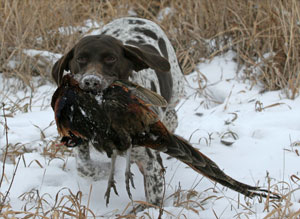
A Well-Trained Dog
Since heavy grass and cover is where you'll find most birds, a well-trained hunting dog can be an invaluable tool for the pheasant enthusiast. The breed of dog isn't important, as long as the dog is obedient, works close and listens. Nothing is more frustrating than hunting with a dog that runs too far ahead, flushing birds out of range.
Here are a couple suggestions to help your dog be more successful. Hunt your dog into the wind. Don’t forget to keep your dog hydrated during the hunt, even on a cool day as this is vital for your dog’s well being. Heat strokes can be fatal.
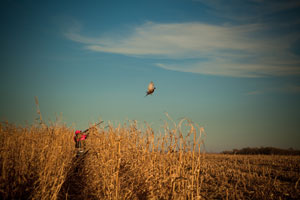
When and Where to Hunt
Pheasants follow a schedule as routine as your daily commute to and from work. Understanding the pheasant's daily movements can increase your odds of flushing a rooster.
Pheasants start their day before sunrise at roost sites, usually in areas of short- to medium-height grass or weeds. At first light, pheasants head for roadsides or similar areas where they can find gravel or grit. By mid-morning, the birds have left the fields for the densest, thickest cover they can find, such as a standing corn, CRP fields, brush patches, wetlands, or native grasses where they tend to remain until late afternoon. During the late afternoon, the birds move from their loafing spots back to the feeding areas.
In general, look for wetlands or other dense pheasant producing cover including wooded land and scrub. Work grassy sloughs, ditches or other brushy areas and cover adjacent to newly harvested crop areas. Later in the season the ringneck pheasant seeks heavier cover in which to hide.
It also helps if you know where and what they eat: they feed on the ground on grain, leaves and invertebrates. Consider areas off the beaten path such as small tree claims and brush in the middle of a section or farmed area. Many pheasant hunters ignore these areas because it takes additional effort to walk them. Don’t forget to check the prairie road ditches with dense cover.
A good time to hunt roosters is when the wind blows. High winds are a pheasant hunter’s best friend as the cover makes more natural noise than the hunter. If you are quiet enough, your sounds will get lost in the wind and the birds get edgy. They do not know where you are or where to go and will end up sitting tighter allowing you to get closer before they flush.
If high winds are good, a blizzard can be even better, especially the next day. If you get a substantial snowfall that is not crusted up, the roosters are unable to run on top of the snow and are forced to sit tight. They will hunker down in areas of good cover. A group of hunters can spend all afternoon in such an area as the birds can't go anywhere but up! Don't be afraid to hunt a patch of cover full of birds, two or three times and remember you can never walk slowly enough.
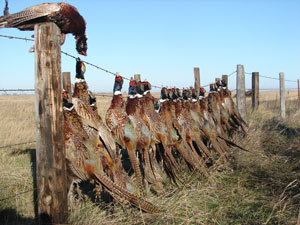
Keep Noise to a Minimum
Pheasants rely heavily on their hearing to detect danger and will often flush wildly hundreds of yards ahead at the first sign of any noise. Slamming a car door, yelling at your dog or even speaking loudly to your buddy can alert pheasants a half mile away and rest assured, they’ll be running in the opposite direction.
Successful hunters find that they will flush more birds by walking slowly and quietly while working back and forth across the field. Let your dog have time to thoroughly cover the field. This forces the birds to either flush or move ahead of the walkers giving blockers at the end of the cover shooting opportunities.
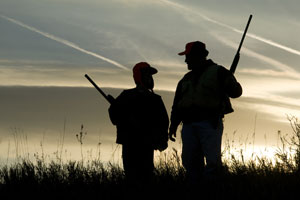
Safety First
Safety is the ultimate consideration when hunting pheasants. Pheasants will bust out of cover behind, between and right under a hunter's feet. Each hunter must know where it is safe for him to shoot. When using blockers at the ends of fields, it's very important for the walkers to know the exact location of the blockers and conversely for the blockers to know where the walkers are. As hunters near the end of the field, they'll need to know who is going to do the shooting. In most cases the blockers control the end of the field, and walkers shoot only at birds that might have been walked by and get up behind them. Rule for all: never shoot at low flying birds no matter where they are!
Hunter orange should be worn by all hunters. If you can't see someone, it's tough to shoot safely. Orange vests, caps (especially caps), dog collars, and dog vests all help to make a safer hunt. Make sure you only shoot at high rising birds that are in a safe line of fire.
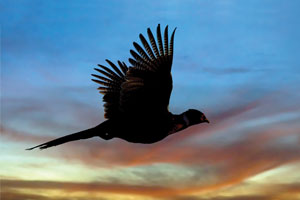
Final Tidbits
It's very difficult for small hunting groups of two to three hunters to work large fields of standing corn. Pheasants often run to avoid predators, a response that frustrates dogs and hunters alike. Groups of only two or three hunters will generally enjoy better success working grass fields, field edges, or fencerows.
When hunting large cover or corn fields, you'll need “blockers." Pheasants are known for their running ability. Blockers are hunters stationed at the end of the field who get shots as birds break from cover. The presence of blockers forces birds to hold tighter, giving both walkers and blockers more shooting action.
Early in the season before they become familiar with hunting pressure, pheasants sit tighter allowing the hunter and dogs to approach closer before flushing. A 12, 20 or 28 gauge shotgun with modified or improved cylinder chokes and #6 shot make an excellent early season combination. As the season progresses, the birds will be flushing wild in many cases, and heavier loads provide a bit more knock down power at longer ranges. For best results you may want to use your 12 gauge along with a tighter choke and heavier loads with #4 or #5 shot.